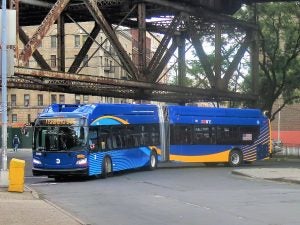New electric buses are a holiday gift for New York City
 Early Sunday morning last week I stood on a windy rooftop in the Hell’s Kitchen neighborhood of Manhattan next to a strikingly modern, blue electric bus. It’s the biggest one I’ve ever seen. It is a 60-foot-long articulated bus that bends in the middle and is fully outfitted with state-of-the-art technology and accessories — from USB chargers to heat.
Early Sunday morning last week I stood on a windy rooftop in the Hell’s Kitchen neighborhood of Manhattan next to a strikingly modern, blue electric bus. It’s the biggest one I’ve ever seen. It is a 60-foot-long articulated bus that bends in the middle and is fully outfitted with state-of-the-art technology and accessories — from USB chargers to heat.
As a climate-solutions advocate, I haven’t been feeling great about the holidays. The news out of Washington, DC isn’t exactly uplifting. The United Nations’ climate talks in Madrid were not easy either and it took too much effort for world leaders to come through with an agreement. Not exactly my idea of holiday cheer.
So, I hauled myself out of bed to join Andy Byford, the president of New York City Transit Authority; engineers from the Metropolitan Transit Authority operations team and a couple of colleagues from the New York environmental community. We all stood on the rooftop overlooking 41st Street to launch the city’s first electric bus into full, regular service — the beginning of the MTA’s initiative to transition to a zero-emissions bus fleet by 2040.
New electric buses are a holiday gift for New York City Share on XThe plan is to roll out 500 of these buses over the next five years and distribute them across all five boroughs. With more than 5,000 buses moving about two million riders a day, the MTA’s is the largest bus fleet in the United States. At that scale, we can help drive down costs and inspire other cities to adopt electric buses.
We demonstrated for the press how to charge the bus, and answered questions. With the current bus fleet in New York City burning millions of gallons of diesel a year, electric buses are a game-changer for communities and the environment. With the purchase of 375 standard buses and 100 articulated buses with all-electric propulsion, the MTA is expected to reduce over 37,000 tons of carbon emissions. While electric buses cost more upfront, they deliver big returns for cleaner air, quieter neighborhoods and lower operating costs. Imagine a city without all that truck and bus noise and pollution.
After a ride downtown, our bus starts the M14 crosstown route and picks up a passenger, who was in awe at the comfortable seats, the digital information system, the serene quiet and the fact that the bus is operating in a special lane that cuts through traffic. Geeks like me care about the battery, the charging infrastructure and what it means for climate. The passenger might care about that too, but for now what he really cares about is getting home with his shopping quickly, affordably and comfortably. And that’s as it should be: solving climate by making people’s lives better.
At EDF, we work to reduce oil and gas emissions by cutting pollution on the industry side and by reducing the demand for fossil fuels. Our goal is for the U. S., China and Europe to complete a near-total transition to electric trucks and buses by 2050. If powered by net-zero emission electricity, this would represent an approximately 40% decrease in global emissions from this sector. To put us on that pathway, we aim to ensure that 30% of new trucks and buses sold in the United States, Europe and China are electric by 2030.
In March of this year, Gov. Cuomo and the New York State Legislature approved congestion pricing, which could help finance the city’s transition to an all-electric bus system. When it starts in 2021, congestion pricing will raise about $1 billion per year to invest in transit, cut traffic by up to 20% and improve air quality — especially in vulnerable communities with high asthma rates where bus depots are often located.
The 14th Street busway that recently closed to all traffic except buses, bikes, pedestrians and deliveries shows what a city can be like with less traffic. While controversial when proposed, the MTA released data that shows bus ridership going up, traffic going down (even on nearby side streets) and commutes getting faster. Quality of life is better with less diesel exhaust and pollution.
I used to avoid 14th street because it was choked with traffic and unpleasant. Today, it seems like a bit of a miracle, a glimpse into the future of a city where people and the planet can thrive together.
On the way out, a bus passenger turned to Andy Byford, and said: “Thanks. This electric bus — what a great holiday present for New York City!”










